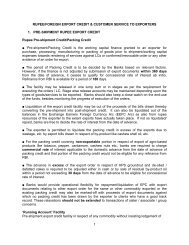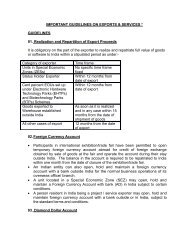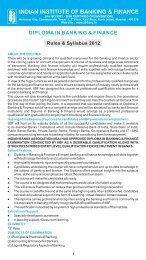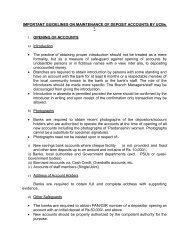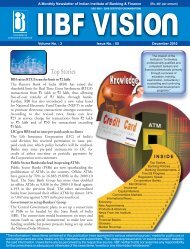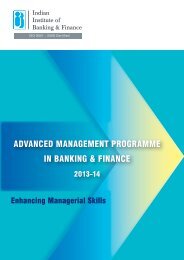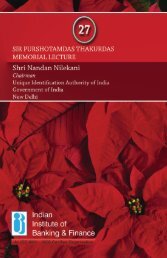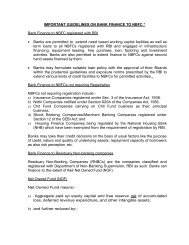You also want an ePaper? Increase the reach of your titles
YUMPU automatically turns print PDFs into web optimized ePapers that Google loves.
special feature7. Learning from the committees :Government of India and Reserve Bank ofIndia from time to time has been supportingbanks in providing better customer service.Several committees have worked on professionallines to make suggestions to improve the qualityof customer service. In the relentless pursuit ofbanks to improve customer service, variousagencies have been contributing to it. In 1975, theGovernment of India had appointed the TalwarCommittee on customer service in banks. In 1990,RBI appointed the Goiporia Committee on customerservice in banks. In 2004, the Tarapore Committeerecommendations led to formation of Board levelcommittees for monitoring customer service inbanks. In 2006, Reserve Bank of India appointeda Working Group to formulate a scheme toensure reasonableness of bank service chargesunder the chairmanship of Shri. N. Sadasivan.The recommendations of the various Committees /Working Groups reflected the need of the time inwhich the Committees / Working Groups were setup.Similarly at the bank level while planning toprovide best customer service, it is more importantto institutionalise systemic controls to check thequality of service delivered across the bank. It callsfor a broad spectrum of checks and balances thatcan capture the qualitative aspects of the service.Taking cue from the recommendations of learnedcommittees, banks can design systems / controls toderive better customer satisfaction levels.8. Award best customer service units :Creation of healthy competition among branchesin providing quality customer service is necessary.Banks can institutionalise appropriate in-houseawards / incentive schemes to recognise theoutstanding work in providing quality customerservice. A suitable assessment matrix bedeveloped to capture the granular components ofcustomer service. Assess them on sustained basisand reward the best branch and best employeescontributing to it. The parameters for assessmentof good customer service needs to be set after aninterface with the customers so that branchesare encouraged to serve customers to meet theiraspirations.9. Analyse CRM data to unveil future needs :CBS has immense potentiality to not only processlarge number of transactions but can amassa huge inventory of MIS for multiple applications.Hence, going beyond the transaction processing,CBS architecture can now be extensivelyutilised to collect data for Customer RelationshipManagement (CRM). The more we know about thecustomers, the better we can serve them. Customerdelight can be targeted only if we havecomprehensive data base. It will also unveilthe future needs and life cycle requirements ofcustomers. Banks will be in a better position tomeet the product needs at every stage of lifecycle right from providing educational loans, vehicleloans, professional loans, personal loans, homeloans, credit cards, insurance etc. Collection andanalysis of CRM data can be the right input to evenplan diversification into new lines of business. Sincemost banks are CBS enabled, they need to go to thenext logical step to put CRM in place to derive its fullsynergy.10.Maintain emotional connect with customers :In a technology led environment wherecustomer touch points are increasingly attendedby call centres, alternate delivery channelsand cash dispensing machines, the customersmay feel isolated without human interface. Insuch working climate, banks can come forwardto talk to customers personally, understand theirpain points and establish emotional connect.Relationship developed with personal interfacecan be more lasting often stretching beyondgenerations.In the whole process of improving customerservice, the efforts of banks were adequatelysupplemented by Reserve Bank, as the regulatorof the banking sector. It has been actively guiding,supporting and is actively engaged from the very12October - December 2011The Journal of Indian Institute of Banking & Finance



